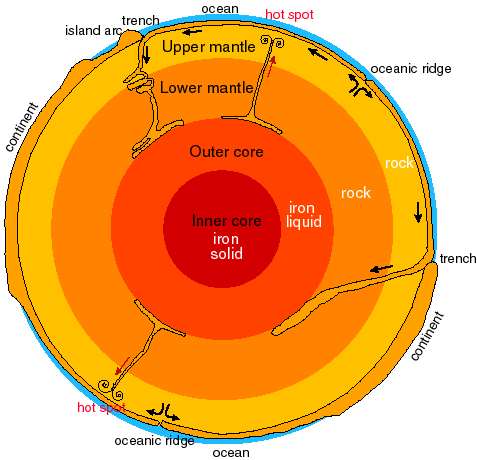I have long been fascinated by the fact that although we have gone so far in space exploration, we find it much harder to penetrate into the Earth. The deepest we get is in the oceans where we have gone to a depth of around 11 km in the place known as Challenger Deep that is located in the Marianas Trench. Here is a graphic of what we know about the Earth.
Note that the drawing is not to scale. To see the actual depths of the various layers, see here
The nature of the Earth’s inner core (the central solid region of radius 1,220 km that is growing at the rate of about 0.5mm each year) is particularly intriguing. Most of our information about the Earth’s core has been obtained indirectly by studying data from earthquake propagation using various theoretical models.
A new study says that our previous understanding of what the core is made up of may need to be revised. (The paper can be read here.)
Seismic data indicate that the western and eastern hemispheres of Earth’s inner core differ, and this has led some to suggest that the core was once subjected to an impulse – presumably from the collision of a space rock or planetoid which shook the whole Earth.
The core, it is suggested, is constantly moving sideways. As it does, the front side is melting and the rear side crystallising, but the core is held centrally by gravity.
With all these seismic complexities, the link between the crystal structure and the geophysical observations has yet to be resolved.
In Scientific Reports, Maurizio Mattesini from the Complutense University of Madrid, Spain, and colleagues propose a novel possibility for the structure of the core: that it is composed of mixtures of different iron arrangements distinguished by the way their atoms pack together.
By comparing seismic data from over one thousand earthquakes across the globe with quantum mechanical models for the properties of iron, they suggest that seismic variations directly reflect variations in the iron structure.
They propose that the eastern and western sides of the core differ in the extent of mixing of these distinct structures, and suggest their results account for the dynamic eastward drift of the core through time.
Their complicated picture of the core contrasts with earlier suggestions of a more uniform mineralogy. It has yet to incorporate the effects of minor amounts of other elements in the iron alloy actually thought to be there.
I was particularly intrigued by the core drifting eastwards through time. Surely there must be a limit to the amount of that lateral movement?
We think of outer space as a hostile place that is hard to explore. But the interior of the Earth is far more difficult even though the distances are so small.


Since iron is melting at the fron surface and crystallizing at the rear, I wouldn’t expect a limit to the movement. The core stays put overall, but the atoms that comprise it are slowly cycling through.